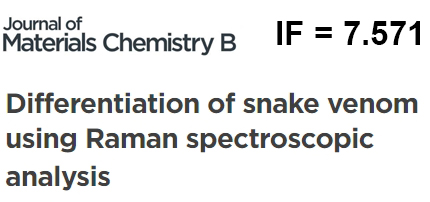Press-room / news / Science news /
Classification of snake venoms using Raman spectroscopy
Scientists from the Department of Molecular Neuroimmune Signaling of the Institute of Bioorganic Chemistry RAS, together with colleagues from the Prokhorov General Physics Institute RAS conducted a study of various snake venoms using Raman spectroscopy and demonstrated the applicability of this method to the analysis of such complex biomolecular mixtures as venoms.
Snake venoms are mixtures of various biological molecules, with proteins being the predominant component. To study the composition of venoms, methods based on chromatography and mass spectrometry are currently used, which are quite labor-intensive and require sophisticated equipment for their implementation.
To assess the composition of snake venoms, authors proposed an alternative method based on Raman spectroscopy. This technique does not require preliminary preparation of samples, and the amount of samples required for analysis is extremely small, which makes Raman spectroscopy very attractive for the study of animal venoms. The Raman spectrum of a protein contains unique information about its structure: in addition to data on the amino acid sequence, the spectrum provides information on the secondary structure of the protein.
In this work, there was conducted a spectroscopic study of dry venoms of various snake species from different genera and families. Based on the obtained spectra, using mathematical methods of dimension reduction (principal component analysis) and clustering, the classification of venoms was carried out, reflecting their composition, and the assignment of the venom-producing snake to the corresponding family or even genus. The proposed method can be used to analyze both the composition of the venom and the venom variations of various snakes, including rare and endangered ones.

Figure 1. A: Principal component analysis score plot showing the division of venom samples into clusters according to their composition; B: Plot obtained by discriminant functional analysis showing the division of samples according to whether a venom-producing snake belongs to the family Viperidae or Elapidae
This study was conducted as part of the work carried out by the cooperation of researchers from the biological and physical teams, aimed at promoting optical methods, in particular Raman spectroscopy, in the field of toxinology. Authors have previously used this method to study the structures of various toxins, and work in this direction will continue.
The results are published in Journal of Materials Chemistry B.
june 30, 2023


